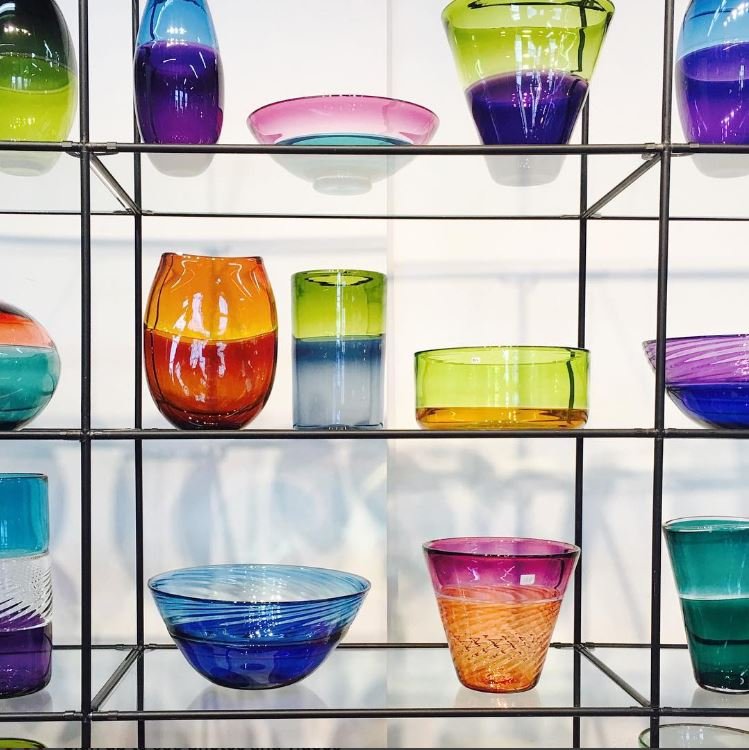So far, we have discussed retail floorplans and consumer behavior, in our “Retail Space” series. Today’s blog post will cover visual merchandising and the key points to remember when creating a retail display.
Creating successful retail displays can seem overwhelming. There is a lot to consider before jumping in, and a lot that can make or break a display. Visual merchandising, when done correctly, can highlight product features and benefits, and maximize sales.
First, let’s talk color. A successful color scheme will attract customers attention, and draw them to a display. Utilizing either contrasting colors, or monochromatic colors, can create eye catching displays. Color can help to tell a brand story, and create a sense of excitement, or serenity and calm, depending on the feel that the retailer is hoping to instill in their shoppers. Warm colors, like oranges and browns are inviting and reassuring, while cooler colors like green and blue have a calming effect. Bright colors, like red and yellow, grab customers attention (as yellow it he first color perceived by the retina, and red is associated with stopping). Colors can also contribute to brand recognition and finding a way to work your logo colors in retail displays can add to that recognition.
Keep in mind, however, that you want the merchandise to stand out from its surroundings, so there can be such a thing as too much color, and too many designs. This will often lead to the customer being distracted from the products you are trying to sell.
Creating a focal point, is also key. What element or product do you want to stand out from the rest? Allow this product to become the “hotspot” and add visual elements around the product itself, that will support it, and not take away from its appearance. It is important to remember to always take a step back and examine the display from where your customers will be standing.
The best retail displays tell a story. The story emphasizes the merchandise and tells the customer why they should purchase the product. Lifestyle graphics, bold letters, signs, moving images, etc. can enhance a product or brands story, and encourage customers to purchase. These tools will also make your retail location more memorable and set the shopping experience apart from others, in customers minds.
Other elements of effective visual merchandising include balance, sizes of objects, lighting, signage, and simplicity. Signage can be directional, informational, or promotional. Visual cues can assist in guiding customers through the store, assist in a sale when sales people are busy, and ensure that your customers have the information about the products that they need.
Effective lighting is crucial when designing a retail display, as it shapes the atmosphere of the space, illuminates merchandise, and can affect customer behavior. Field studies have shown that customers spend more time in areas of a store that has warmer lighting and that the average sale per customer increases by 1.93% when a dynamic lighting installation is introduced. Primary lighting illuminates the entire store, while accent lighting draws shoppers focus to a specific display or product, and ambient lighting sets the mood. All three forms should be taken into consideration when styling a display.
Product grouping can be used to create a story with merchandise, grab customers attention, and increase sales of additional objects. The best product groupings are often done in odd numbers (customers brains are triggered by imbalance) and incorporate an item that stands out. Varying heights of product displayed, or decorative items, also can assist in catching a customer’s attention. A clear focal point is often accomplished by using the Pyramid Principle, or arranging product with the largest item at the center and small supporting products on the outside, so that the other items “step down” from the focal point.
Window displays are primary real estate for displaying new products, trending products, or decorative items that relay the brand image you are hoping to achieve. Clutter in window displays should be avoided at all cost. It is important to ensure that there is adequate space around products being featured, as well as repeating design elements highlighting a variety of products.
Overall, visual merchandising is a strategy. A strategy that maximizes the aesthetics of a product with the intent to increase sales. There are many factors involved and many ways to go about creating a successful retail display. Hopefully these tips will help to get you started!










Leave a reply
You must be logged in to post a comment.